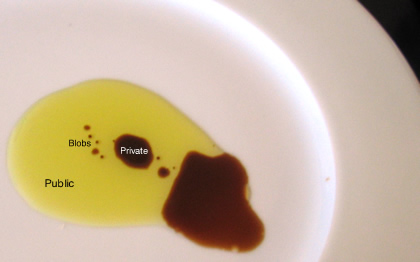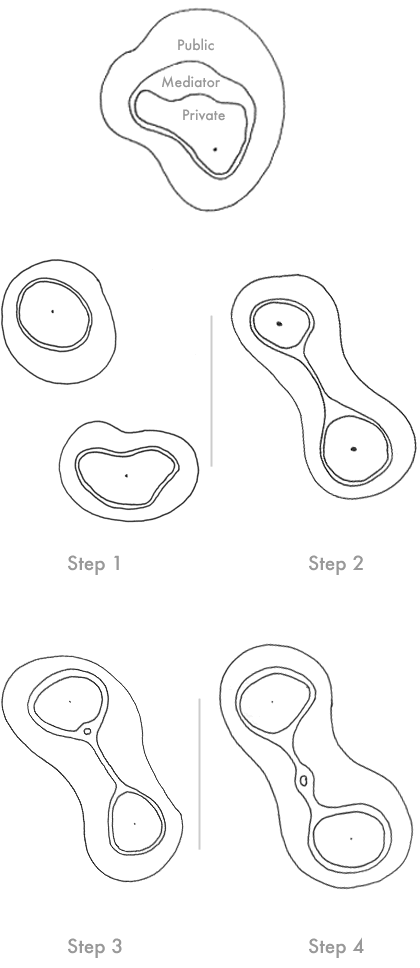
Oil and vinegar describe the decay and archiving of data over time, as well as a relationship between public and private information.

The interaction of oil and vinegar on a plate describe the relationship between public and private information in the personal space surrounding an individual, as well as the flow of information between devices.

The desktop metaphor no longer functions as an efficient metaphor for managing ever-increasing amounts of data storage and the relationships of always-on, highly-networked devices.

In the Fluid Data metaphor, data transfer assumes an organic nature, allowing for complex relationships while being easily understood through its similarity to everyday phenomena.

Data transfer and permissions between people and objects takes advantage of the clear distinctions between public and private space.
As hard drive capacities increase, our mental model for understanding computers—the desktop metaphor, replete with folders, clip-boards, and trash bins—begins to break.
Fluid Data suggests an alternative to the desktop metaphor, proposing new means of understanding data storage and manipulation.
Brief Data storage technology is allowing for an ever increasing amount of personal memories to be stored.
Despite this advance in capability, storage devices and operating systems become obsolete and unavailable, and their media degrades. How could we ensure that a person’s lifetime of memories stays accessible? And how might he or she find their way around a data vault representing that lifetime’s memories?
Students were asked to 1) design detailed scenarios of how people in 2010 might access, navigate, share and annotate digital memories, and 2) prototype appropriate interactions or interfaces.
Data Archiving Drawing inspiration from the interaction of oil and vinegar in a wine glass and on a plate, Fluid Data treats the behavior and manipulation of information as liquid and organic.
Data storage and archiving can be seen as a settling of sediment over time: infrequently-used data sinks to the bottom for archiving, while active and current data remains near the turbulent top layer. Searching then becomes an act of filtering, stirring through archived layers of data while dredging for information—data access is directly correlated with meaningful spatial organization.
Data classification If the natural strata of oil and vinegar informs the concept of data storage and archiving, the interaction of elements on a horizontal plane intuitively suggests a partitioning of public and private, the separation of elements equating with a separation of data types.
This organic visualization of data separation helps to describe data security and permissions, making obvious the distinction between data types. By comparison, the static hierarchy of the desktop and folder are ill-suited to describe and enable data transfer in an increasingly networked world—simply put, your desktop is an inherently private space, and how exactly does one share a folder with multiple people at one time?
Data transactions In the Fluid Data metaphor, information transactions take place using data “blobs” which flow between private spaces through the public data space. Mediator layers act as verification and data analyses agents (similar to virus scanners and spam filters), ensuring data transactions respect the integrity and security of each party’s private data layer.
Although the model suggested thus far makes use of two data layers, multiple data layers are probably more reasonable and comprehensive. Distinctions can then be made between private, semi-private, semi-public, and public data, with multiple classifications within each data layer as necessary.
Data access The Fluid Data metaphor can expand to explain data interaction within the physical world as well.
Personal data becomes attached to an individual or a particular object, and ad hoc networks form discreet, temporary connections between parties involved in a meeting or a conversation.
Interaction and transactions can occur between public data layers or, with permission, between private layers. Personal data can inhabit an external device, flowing back into its owner after a specific period of time.
Data access then becomes universal, with data connected to individuals who control when, where, and in what it appears.
In summary Fluid Data presents a flexible and rich metaphor capable of handling the large amounts of data we will manage in the future.
Fluid Data describes transitions from active to archived data, separation of public and private information, methods of data verification and security, and data transaction protocols used to communicate between people and devices.
The metaphor expands to include and inform behavior in the real world, such as how we share and collect information or how we physically manipulate virtual representations of data.
Fluid Data is inherently scalable and suggests a number of different visualizations for data and network communications.
